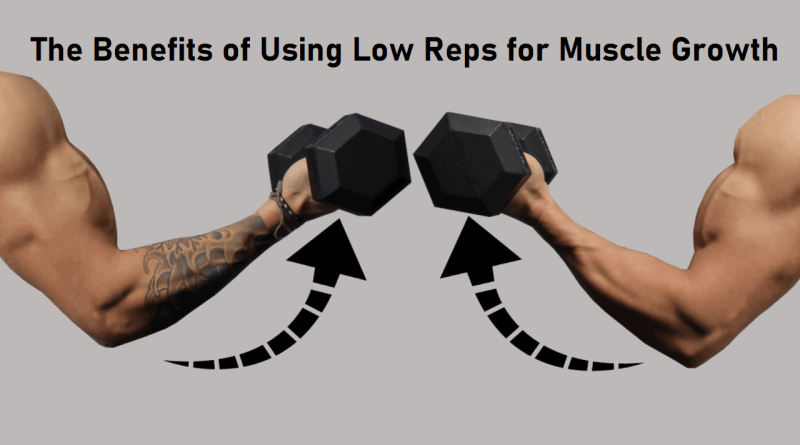7 Reasons Why You Should Incorporate Low Reps Even If Your Goal is Hypertrophy
If you’re currently training to pack on some serious muscle mass, chances are good you’ve been working in the moderate rep range.
You’re hitting the gym regularly, four to five times per week, doing your 8-12 reps per set, hoping to see larger muscles develop as a result.
And, you’ve seen some progress. So far, what you’re doing seems to be working, so your current game plan is to simply keep up those efforts and hope for ongoing results.
But, in doing so, you might be missing out on much greater results. One major mistake made by those training for hypertrophy is to only train in hypertrophy rep ranges. While it’s true that that medium rep range is great for increasing the size of your muscles, size doesn’t stand alone.
If you want to see ongoing results, strength also needs to be the focus. And, to gain optimal strength, lower rep ranges are needed.
That’s not the only reason why lower rep ranges are beneficial however. There are multiple reasons why you might just want to consider adding a few lower rep sets to your next workout.
Benefits of Low Reps
Let’s go over seven of these reasons so that you can see why low-rep strength training is of benefit to you.
Build Strength To Promote Hypertrophy
The first reason is as just stated, strength gains typically precede size gains. Look at it this way, an increase in muscle size comes about most effectively from overloading the muscle tissue with a high amount of volume.
And, volume is made up of how much weight you lift multiplied by how many reps you perform.
So let’s say you’re curling 60 pounds for 8 reps. This means you’re doing a total volume of 480 pounds.
A few weeks later, you’re able to bump that up to 10 reps. Now you’re doing a volume of 600 pounds. A few more weeks and you’re up to 12 reps. At this point, your volume is 720 pounds.
You could keep going – bumping the weight up to 15 reps, then 18 reps, then 20 reps, but at each of these rep ranges, the overloading stimulus being place on the muscle, that is how much sheer stress becomes less and less. Your body is simply able to handle this weight without much of a challenge. It’s no longer an exercise is strength, it’s an exercise in endurance. And, endurance training does not lead to larger muscles (just look at your typical high performance marathon runner).
So the next step after that is to increase the weight upwards. With this new increase in weight, you may not be able to get to the 8 reps any more. Say you increase the weight to 70 pounds. Now you’re doing sets of six. You might think that because it’s so low, you aren’t gaining size.
And at this very moment, you might not be. But, you’re gaining strength. Soon, as your body adapts and gets stronger, you will be able to do those 8 reps, then the 10 reps, then the 12 reps.
Once you can, your volume will now be higher – 840 pounds at 12 reps of 70 pounds, meaning size gains will have been seen.
If you had never increased the weight and gone down into that lower rep range to gain strength, this wouldn’t have occurred.
So think of low rep strength training as a way to promote greater gains when you move into the higher hypertrophy rep training.
Provide A New Stimulus For Performance Improvements
Another reason to consider using lower rep range training is simply for sake of variety. Remember that your body is going to adapt to ongoing change. If you are constantly working in the 8-12 rep range, your only variety is with regards to the exercises you use, the rest you take, and the sets you perform.
By adding lower rep training into the mix, you increase the variety that you your muscles are subjected to. This in turn enhances their performance and can mean to ongoing results.
Without it, you could eventually hit a performance plateau, upon which frustration will quickly set in.
If you were to use a periodized program for instance, you would have a strength phase, a hypertrophy phase, and a performance phase. Each phase will provide transfer over benefits to the next phase, so even though you may no be growing while doing your strength phase, you will still be reaping benefits.
Improve Your CNS Efficiency
The next big benefit you can expect to see from using a lower rep range with your training is increased CNS efficiency. Remember, each time you hit the gym, you aren’t just working your muscles. You’re also working your central nervous system, which basically controls each and every muscular contraction that takes place.
The stronger your CNS output is, the more volume you’ll be able to tolerate in any given workout session. This is also why many new trainees can’t hit the gym for a workout of 30+ sets. If they tried this, they’d quickly become burnt out and overtrained.
A more advanced trainee however may be much better able to tolerate that workload as their CNS has been conditioned to handle it.
Heavy weight, lower rep lifting is the best strategy for boosting your CNS efficiency and output, so you will gain great value here.
By adding periods of very heavy lifting into the mix, you’ll find that your moderate hypertrophy training isn’t as systematically draining, which may mean you can then increase the volume, seeing greater strength gains.
The more conditioned your CNS is, the lower risk you’ll be at for overtraining as well.
Increase Mental Drive
The next benefit to lifting in the lower rep range is simply greater mental drive. If you’re aiming for a max 3-rep squat for instance, it’s going to take all the mental will power you’ve got. You’ll need to be focused, dialed in, and ready to fight with all your effort.
Doing sets like this will help you learn to push through pain and generate the level of mental determination needed to get through any challenge that comes your way.
You can then transfer this over to your hypertrophy training, pushing harder than you ever have before.
Many people in fact regard low rep training to be just as much of a mental workout as it is a physical one.
Tap Into Different Muscle Fibers
The next benefit you stand to gain by working in lower rep ranges is increased adaptations to your fastest twitch muscle fibers. These muscle fibers are going to come into play in moments of sheer and maximal output, such as that when doing a 3 rep set.
While they will still be recruited to some degree during your higher rep sets of 8-12 reps, it’s not the same as the weight simply isn’t nearly as great.
By training across various rep ranges in your workout program, you can ensure that each and every muscle fiber in your body gets worked. This in turn will lead to greater overall adaptations and improved performance.
That then means greater size gains over time. Remember that while hypertrophy training may require a certain type of protocol, there are many ways that you can boost your ability to perform that protocol, therefore boosting your capacity for growth.
Improve Power
Lower rep training is also very excellent for improving your power output as well. Power is determined by how much total weight you can lift over how long of a time period it takes to lift that load.
The stronger you are, the greater your overall power development will be. This will help improve performance on all other athletic activities you may participate in and can also boost your overall output during your hypertrophy workout session as well.
Power training can be excellent for building very dense muscle tissue, so as you do grow larger, you look great at the same time.
This is also the type of size gains that will last, standing the test of time.
Gauge Progress
Finally, the last reason to use the lower rep range on occasion is to simply gauge progress. By testing your one or three rep max for instance, you can see how strong you’re getting and the level of performance improvements you’re seeing.
Even if you are training for muscle size, it’s good that muscle size to be functional – meaning, you’ve gotten stronger.
Using the lower rep range allows you to assess for this most optimally, leading to better feedback about how well your program is working.
So as you can see, there are many reasons to consider using the lower rep range within the overall context of a hypertrophy-based program. Don’t just think that lower rep sets are for powerlifters. They can be just as useful for someone looking to fill out their frame, adding quality lean muscle mass.



